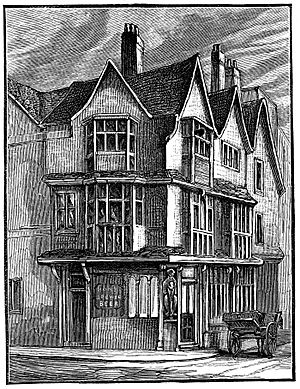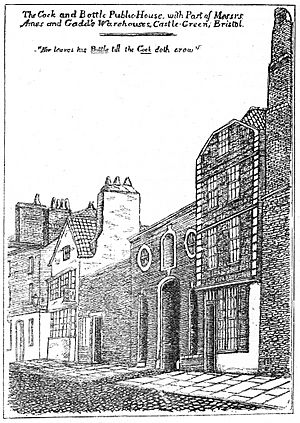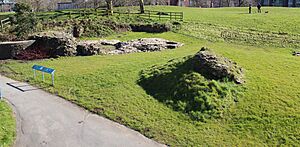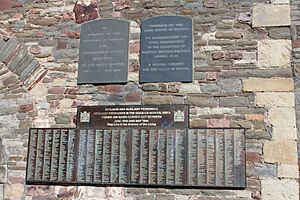Castle Park, Bristol facts for kids
Quick facts for kids Castle Park |
|
|---|---|
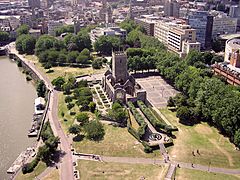
Western part of Castle Park, with ruined St Peter's Church, garden and square in centre and Bristol Bridge in top left
|
|
| Lua error in Module:Location_map at line 420: attempt to index field 'wikibase' (a nil value). | |
| OS grid | ST592731 |
| Created | 1977 |
| Operated by | Bristol City Council |
Castle Park is a large public park in Bristol, England. It is a green space managed by Bristol City Council. The park is located near the Floating Harbour and is surrounded by several streets. It is a popular spot for people to relax and enjoy the outdoors.
The park officially opened on September 30, 1978. It sits on the site of what was once Bristol's main shopping area. This part of the city was heavily damaged during the Bristol Blitz in World War II. Most of the buildings were destroyed by bombs. Anything left was later taken down by 1969. Since the war, Castle Park has become home to several memorials. These remember those who fought against fascism.
In the middle of the park, you can see the ruins of St Peter's Church. This church dates back to the 14th century. Next to it is a special herb garden. It is designed to be enjoyed with all your senses. There are also five silver birch trees here. They are a memorial to the beaches of the D-Day landings. To the east, you can find grassy areas and the remains of Bristol Castle. This old castle once had a massive stone tower. A bandstand is also located in the park.
North of St Peter's Church is St Peter's Square. This area has hosted different events. In the past, a large tethered balloon offered rides for great views. Plans to build new buildings on the park's western edge have caused some debate. Some want to extend the park. Others want new buildings to connect different parts of the city.
Contents
Exploring Castle Park's Past
The city of Bristol began a long time ago. It was settled during the Anglo-Saxon period. This was on the north side of the River Avon. The original town was located near where Castle Park is today.
Bristol Castle was built in the late 11th century. It was a very large structure. The castle's main tower was as big as the one at the Tower of London. This castle covered the entire eastern part of what is now Castle Park. It was home to the Norman soldiers.
By the 16th century, the castle was falling apart. After winning the English Civil War, Oliver Cromwell ordered it to be destroyed in 1655. This process was finished very quickly. After the castle was gone, new shops opened along Castle Street. This created a busy route into the heart of Bristol.
Wine Street and Castle Street became the main shopping areas. Famous stores like Boots and Marks & Spencer had shops there. The area also had a cinema and many small, independent shops. A very famous building called The Dutch House stood at the corner of High Street and Wine Street.
The Bristol Blitz
On November 24, 1940, many German planes attacked Bristol. Their goal was to destroy Bristol's factories and port. They dropped many bombs, including explosives and fire bombs. Fires burned fiercely across the city all night.
A large part of Bristol's historic center was ruined. The main shopping streets, Wine Street and Castle Street, were almost completely destroyed. This event changed the city forever.
Rebuilding Bristol
After the war, people started thinking about how to rebuild Bristol. Some suggested moving the main shopping area. They wanted to create a large open space where the old shops used to be. This was because the old shopping area was very crowded. This crowding had made the fires worse during the bombing.
Many large stores wanted bigger sites for their shops. However, smaller, independent shop owners did not want to move. They felt the new shopping area was too far away. There was a lot of debate about what to do.
By 1966, new shops had been built in an area called Broadmead. The old Wine Street and Castle Street area was used for car parking. Finally, in 1977, work began on the new Castle Park. It was designed by Bristol City Council. The park became much larger than first planned.
Castle Bridge
In March 2016, plans were approved for a new footbridge. This S-shaped bridge crosses the Floating Harbour. It connects Castle Park to the Finzels Reach area. The bridge cost £2.7 million and opened on April 6, 2017.
Cool Places to See
Not much of Bristol Castle is left above ground. You can still see a vaulted room from the King's Hall. This was part of the castle. You can also see parts of the castle walls near the river. The foundations of the main tower are visible near the public toilets.
The park has several important memorials. The ruined St Peter's Church is a memorial. It remembers the people who died during the Bristol Blitz. A plaque on its wall lists their names. Next to the church is a sensory herb garden. There is also the Normandy Garden of Peace. It has five Silver Birch trees. These trees remember the five beaches of the D-Day landings. There are also memorial trees for Anne Frank and the victims of the atomic bombings of Hiroshima and Nagasaki.
You can also find a memorial plaque in the park. It is dedicated to Bristol citizens. These people died fighting in the Spanish Civil War. The plaque is framed by a mosaic. It shows the colors of the flag of the Second Spanish Republic.
The ruined tower of St Mary-le-Port church stands on the western edge of the park. This church tower was even featured in a painting. That painting appeared on a postage stamp in 1968.
Important Buildings and Sites
Castle Park has several buildings and sites that are protected. This means they are historically important.
| Location | Grade | Year Listed | Description |
|---|---|---|---|
| ST 58992 73026 | Scheduled monument | 1949 (amended 2009) | St Mary-le-Port Church |
| ST 58980 73017 | II | 1959 | Tower of church of St Mary-le-Port |
| ST 59104 73117 | Scheduled monument | Medieval vaults North of St Peter's Church | |
| ST 59122 73096 | II* | 1959 (amended 1995) | Church of St Peter, Castle Park |
| ST59220 73158 | II | 1959 (amended 1995) | Castle keep remains |
| ST59354 73230 | II | 1959 | Castle wall remains |
| ST 59373 73129 | Scheduled monument | Bristol Castle vaulted chambers | |
| ST 59372 73128 | II | Vaulted chambers at Bristol Castle |


